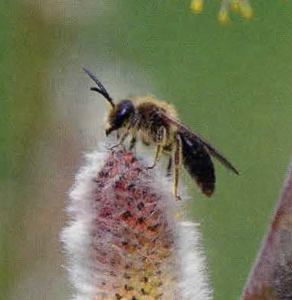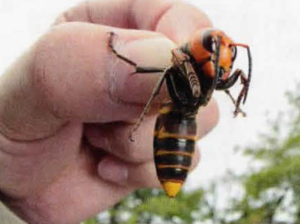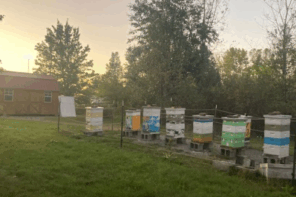By: Ann Harman
This article originally appeared in the Winter 2018 issue of BEEKeeping Your First Three Years
Now that you are a beekeeper everyone you encounter will want to tell you their Sting Stories. Sometimes they are very long and complicated – but rarely about honey bees. Many people get stung by yellow jackets when mowing the yard or doing some other garden work. Unfortunately yellow jackets are sometimes called “ground bees” but they are not bees at all so that nickname seems a bit unfair to honey bees. You may receive phone calls from someone asking if you would like to have the “bees” they just found. After some careful questioning, you may realize that these “bees” are not honey bees. However, the caller may think you can do something about those “bees.”
There actually are some solitary bees that do nest in the ground. They are the mining bees, small, usually dark bees that prefer loose, somewhat sandy, soil to dig their nest. When an area of suitable soil is available sometimes quite a number of these bees will choose to nest, not as a colony, but as an aggregation. People do find that a number of these nests together are frightening. These mining bees are very docile, not at all defensive. Although these are bees and have a stinger, that stinger would have great difficulty piercing human skin. If you were digging in their nest site you could get stung if you annoyed them.
The mining bees dig a hole straight down and dig chambers off the hole. An egg is laid and provisioned with a pollen/nectar pellet. The larvae will consume the pollen, become a pupa and spend the Winter underground. Depending on the species, the adult will emerge the following Spring or Summer and mate. The life of the adult bee, again depending on species, will only be four to six weeks.
The mining bees, like all the other solitary bees, are important pollinators and need to be protected. Fortunately, many people now understand their importance and are becoming acquainted with the solitary bees. The “bee hotels” of various types and sizes are being sold and used. The mining bees will not be using these hotels but many other pollinating bees will.
Perhaps the most annoying ground-nester is the yellow jacket. Most are cavity-nesters but the nest is made of paper inside the chosen cavity. It is a seasonal nest. Used one season, then abandoned. A mated queen who has overwintered in a somewhat warm place will emerge as the Spring weather warms. She will seek a cavity that can be in the ground but also in a wall or perhaps in a piece of seldom used equipment. The queen will construct a small piece of paper comb, lay some eggs and raise some workers who will then take over the duties of enlarging the nest, caring for the developing larvae and foraging for food. Unfortunately they occasionally select a cavity that creates a problem for us. Yellowjackets are defensive, quick to sting if provoked. The stinger is smooth so a yellow jacket can sting repeatedly until she runs out of venom, usually after four to six stings.
The larvae are fed “meat.” That meat (proteins) are the insects that are eating up your flower and vegetable gardens! Yellow jackets are highly beneficial insects! The active workers use nectar from flowers or juices from sweet or rotting fruit for energy. Yellow jackets can be a nuisance at picnics when searching for soft drinks and beer. At a picnic to prevent getting a mouthful of drink along with an angry yellow jacket, pour the drink into a glass where the insect can be seen and removed. Use caution when picking up fruits, especially slightly rotten ones, that have fallen on the ground. You may be picking up a yellow jacket also.
As Summer is progressing into Autumn, reproductive – queens and males – are produced. As the current workers slowly die, as well as the males, the colony dwindles. Depending on species and climate, the colony will die any time from August into December. Although a number of queens are produced and attempt to overwinter, only about 2% will survive to start the cycle again. One species, Vespula germanica, can overwinter in warm climates. This species does prefer nesting in walls of houses and sheds.
Not all yellow jackets are cavity nesters. Five species, called aerial yellow jackets, are scattered across the U.S. and Canada. These yellow jackets build those gray paper “balls” that hang in shrubs and trees. These nests are also seasonal; the nest usually falls apart during the Winter months. One of these yellow jackets, common in the east, is called the “bald faced (or whitefaced) hornet.” It is not a hornet! Its coloring is black with white trim and stripes; no yellow jacket yellow to be seen.
Actually only one true hornet lives in the U.S., basically in the eastern half . It is the European hornet (Vespa crabro) that arrived in this country in the mid 1800s. It makes a fragile brown paper nest in a cavity, most frequently a hollow tree . Yes, it too is beneficial since it preys on a number of insects, especially large ones. It may capture an occasional bee. It has an alarming habit of flying to lights at night. If left alone it will return to its nest when the light is turned off. This hornet will chew the bark on some shrubs, sometimes girdling branches.
At present parts of Europe (France, Spain, Portugal) and the Channel Islands are having great problems with the Asian hornet, Vespa velutina, that arrived recently in France. This hornet preys on honey bees and will actively “hawk” in front of hive entrances to capture honey bees going in and out. It builds huge aerial paper nests that contain a large population of hornets. Honey bee colonies can lose enough foragers that the colony weakens to the point of collapse. Although it does capture other insects to feed its larvae, it is considered a serious pest insect, not at all beneficial.
Wasps are another group of stinging insects that construct their nests in various ways and exhibit quite varied behaviors. Yes, these are beneficial, too, by feeding their larvae “meat”. Sone wasps are very, very tiny ones that you may never notice. Some of these are parasitic, laying eggs inside a harmful insect. The developing larva feeds on its host, eventually killing it.
The paper wasp constructs an open comb with no envelope or cover over it. The comb hangs down from a strong “stem” fastened under an eave or inside a shed or other shelter. The seasonal population of these is usually quite small. These wasps are generally quite defensive if they sense any disturbance. However you can watch them at work from a safe distance. Do not interfere with their flight path.
The wasps and hornets that make paper nests are actually making paper. Paper for books and newspapers is made from shredded wood mixed with water, poured onto a screen, drained and dried. The insect workers visit unpainted wood, such as fence boards, sheds with unpainted siding or wood from fallen trees. They chew off small bits with their mandibles and mix it with their saliva and stick the wet bits to nest surfaces. When dry it is truly paper.
Mud dauber wasps are solitary ones and are generally quite docile. If you happen to be in their flight path they simply fly around you. These wasps fashion wet mud into pipes – some are upright on a surface and are called “organ pipes”; others make horizontal tubes and some species clump the pipes together and cover them with a layer of mud. The mud pipes will be found inside structures to prevent being softened or washed away by rain. The beneficial mud daubers are the ones keeping spiders of all kinds and sizes under control. Each larva will be provisioned with an assortment of anesthetized spiders.
An interesting wasp is the solitary one called cicada killer. During July and August in areas that have cicadas this wasp can be seen flying low over the ground in search of emerging cicadas. These wasps are one of the digger wasps. The nest is a tube-shaped cavity in the ground. The captured and paralyzed cicada will provide food for the developing wasp larva. The cicada killers are quite docile but the sight of some rather large wasps cruising low to the ground can be alarming.
Bumblebees are spectacular pollinators. The workers range in size from less than half an inch to a full inch. We recognize them from their bright-colored fuzzy hairs, black, yellow and sometimes orange-red. Many species live underground in old mouse nests; some will live in piles of grass, hay or straw. If you disturb the nest you will get stung! The nests are seasonal, begun by an overwintered queen. She will construct the first cells of wax for nectar storage then will lay some eggs in wax pots containing pollen moistened with nectar. When the first adult workers emerge they will take over the duties of enlarging the nest by building more wax pots, caring for the developing larvae and foraging, while the queen will just continue to lay eggs. As Summer is ending, reproductives will appear. Mating takes place at this time. Only the mated queens will overwinter.
Bumblebees are important pollinators for tomatoes and sweet peppers because they perform buzz pollination. They grab the blossom with their legs and vibrate the thorax muscles. The pollen shakes loose and falls into the hairs of the bumblebee and also get circulated within the flower. The bumblebee is also used in greenhouses for pollination. The honey bee does not perform buzz pollination and is hopeless in greenhouses. When a honey beehive is put in a greenhouse, the workers do fly out of the hive but lodge themselves up at the top of the greenhouse in a clump, ignoring the flowers.
Another bee, the carpenter bee, is frequently confused with the bumblebee. The size and color and markings may appear similar. You can tell the difference easily – the abdomen of the carpenter bee is hairless and quite shiny black. The abdomen of bumblebees is covered with black, yellow or orange-red hairs. Behaviors are quite different.
Carpenter bees do not form colonies with queens and workers. They are considered solitary bees. Both males and females overwinter then mate in the Spring after emergence. The female is the one that uses her mandibles to chew a hole in wood. Usually this wood is unpainted or has not been treated and may be beams under decks or in open sheds or in other boards of a house or structure. She will chew a tunnel and proceed to visit flowers to collect pollen. Her hind legs are hairy for the collection of pollen. So, although somewhat destructive in their boring of holes, carpenter bees are pollinators.
Only about four to six eggs are laid, one in each cell sealed with a wall of chewed wood. The males will hover near nests and will threaten animals and people who come near. But the males cannot sting. Remember, stingers are modified egg-laying parts, found on females. Many people panic when confronted by a male carpenter bee so his efforts are rewarded. The female, who does have a stinger, is actually very docile and does not defend the nest. When the female finishes laying her eggs and leaves the nest the male will leave. This generation of carpenter bees will die during the Summer months. In late Summer to early Autumn the eggs laid in the Spring have developed and the bees will emerge as adults. These will overwinter, unmated, and the cycle begins again in the Spring.
Now that you have met some of your honey bees’ relatives, you can give some accurate information to the non-beekeepers who may contact you about “those bees.”



















